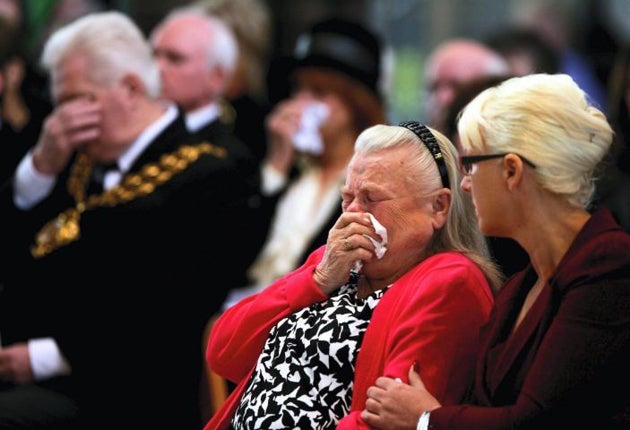'I will fight for evermore until I find him'
Search still on for Keith Bennett, 46 years after he was killed by Ian Brady and Myra Hindley

Had Keith Bennett lived, he would be 57. But aged just 12, he was snatched by Ian Brady and Myra Hindley one summer day in 1964 as he walked to his grandmother's house. He was to become the third of the couple's five victims and, as with all the others, his body was buried in the dank peat of Saddleworth Moor, in the South Pennines.
Unlike the other four – Pauline Reade, John Kilbride, Lesley Ann Downey and Edward Evans – Keith's remains have never been found, and Brady, who confessed to the murder only in 1987, refuses to reveal where he buried the lad.
There has been no funeral in the 45 years since Keith disappeared. But even yesterday, as the people of Manchester gathered in their hundreds amid the splendour of the city's medieval cathedral to celebrate this long-lost boy's short life nearly five decades on, his mother refused to give up hope that one day his remains would be found.
Winnie Johnson, now 76, broke down repeatedly as she restated her determination to live to see her son brought back down off the moors for a proper burial. A frail figure, face heavily lined from years of grief, her long grey hair scraped back and held with a black band, her bright pink cardigan weighed down with tissues to catch the inevitable tears, she introduced herself simply as "Keith's mother".
With supporters on each arm in case she collapsed she thanked those friends and family who had never abandoned her as she waited for the police investigation to yield results. But last year, despite one last effort to find the little boy using new hi-tech equipment – an effort which produced little more than a few sheep bones – Greater Manchester Police called off their long search.
Unless new evidence emerges, they will not look for Keith again. Investigators paid for by a private trust will continue to scour the windswept landscape for clues to the burial site of the third victim murdered by Brady and Hindley, who died in prison in 2002, aged 60. "I have lived through this knowing he is up there on the moors," Mrs Johnson said yesterday. "I want him back. I'd go anywhere, do anything for him. I will still fight for evermore until I find him and I hope I find him before I'm dead. I do wish one day he will be found."
She stood beside a spray of yellow roses and a painting based on the poignant photograph of her young son immediately recognisable to the millions haunted by the savage crimes. With his toothy grin, tousled blond hair and NHS spectacles, he was a thoroughly normal lad, the congregation heard, popular and fun-loving, living a typical working-class childhood at a time when society was being transformed around him.
Keith loved The Beatles, and collecting leaves and coins. The little Manchester City fan also liked playing marbles in the street outside his Longsight home. He had tinkling bells sewn into the turn-ups of his jeans, and a family friend, Norie Miles, told of a time Keith "stomped" to the delight of his fellow passengers on a city bus.
The Right Rev Nigel McCulloch, Bishop of Manchester, paid tribute to Mrs Johnson, who had eight children, saying she had "persevered through hail, rain and snow" to find her son. He told the congregation that "the lost sheep may now forever safely rest".
Professor John Hunter, an archaeologist who has helped investigate mass graves at Srebrenica in Bosnia, said he had spent much of the past two decades searching for Keith and he, too, believed he could be found. He said there was no "black magic box" to help them, only hard work, but his experience taught him the discovery of a body could bring vital closure to grieving families.
